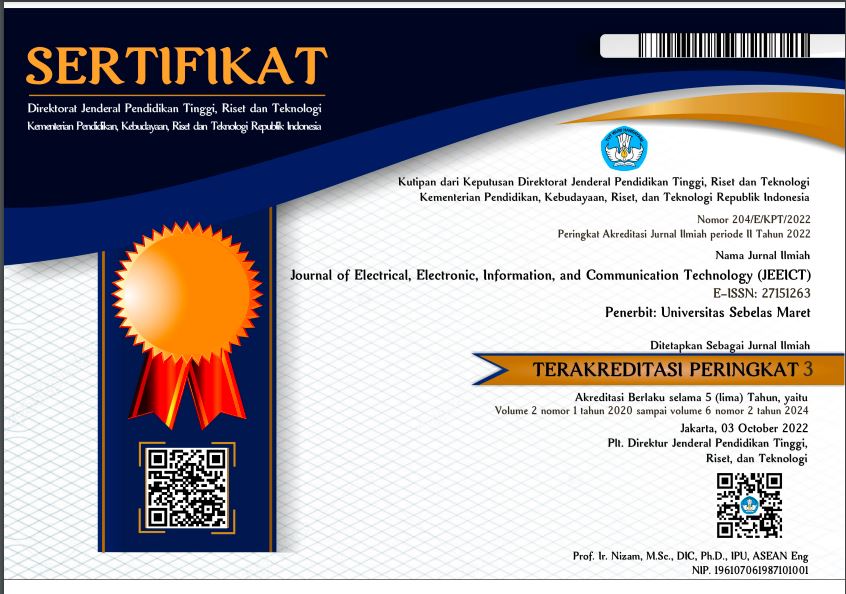Technology Design to Improve Plant Quality with IoT-Based Plant Temperature and Humidity Monitoring System
Abstract
Full Text:
PDFReferences
W. A. Prayitno, . A. Muttaqin dan D. Syauqy, “Sistem Monitoring Suhu, Kelembaban, dan Pengendali Penyiraman Tanaman Hidroponik menggunakan Blynk Android,” Jurnal Pengembangan Teknologi Informasi dan Ilmu Komputer, vol. Vol. 1, no. 4, pp. 292-297, 2017.
I. A. Darmawan, “Pengaruh Topoklimat terhadap Produksi dan Kualitas Selada (Lactuca sativa L.),” Universitas Gadjah Mada, Yogyakarta, 1997.
B. M dan J. A, “Student Presence Using Rfid and Telegram,” Widyatama University and IEEE, 2016.
A. H. Alasiry, E. Suryawati, E. Satriyanto dan R. R. A, “Desain dan Implementasi Jejaring Sensor Nirkabel Inframerah untuk Sistem Informasi Parkir Gedung Bertingkat,” EEPIS, 2010.
A. Raafi’ilman, A. Bhawiyuga dan R. A. Siregar, “Implementasi Protokol RF24Mesh dalam Wireless Sensor Networkpada Lahan Pertanian,” Jurnal Pengembangan Teknologi Informasi dan Ilmu Komputer, vol. 3, no. 7, pp. 6757-6763, 2019.
T. A. Prabowo, “PROTOTYPE SEDERHANA PENGENDALI LAMPU,” dalam UNIVERSITAS PELITA BANGSA, BEKASI, 2019.
B. Frasetya, A. Taofik, R. dan F. , “EVALUATION OF VARIATIONELECTRICAL CONDUCTIVITY VALUE ON THEGROWTH OFLETTUCE (Lactuca sativaL.) IN THE NFT SYSTEM,” Jurnal Agro, vol. 5, no. 2, pp. 95-102, 2018.
Aosong, Temperature and Humidity Module DHT11 Product Manual, Aosong Electronic, 2019.
H. A. Fani, S. J. D. Hartama dan I. Gunawan, “Perancangan Alat Monitoring Pendeteksi Suara di Ruangan Bayi,” JURNAL MEDIA INFORMATIKA BUDIDARMA, vol. 4, no. 1, pp. 144-149, 2020.
N. H. Lusita Dewi, M. F. Rohmah dan S. Zahara, “PROTOTYPE SMART HOME DENGAN MODUL NODEMCU ESP8266 BERBASIS INTERNET OF THINGS (IOT),” Universitas Islam Majapahit, Mojokerto, 2019.
R. WIJAYANTO, “SISTEM PENGENDALI IRIGASI PERTANIAN DESA NGUKEN BERBASIS WIRELESS,” UNIVERSITAS TEKNOLOGI YOGYAKARTA, YOGYAKARTA, 2018.
H. Firdhausyah, R. Maulana dan E. Setiawan, “Sistem Pendeteksi Atrial Fibrilasi BerdasarkanFitur Mean, Median, Standar Deviasi, Min, Dan Maks Interval RRMenggunakan Metode K-NN,” Jurnal Pengembangan Teknologi Informasi dan Ilmu Komputer, vol. 5, no. 6, pp. 2327-2333, 2021.
P. Ferdiansyah, R. Indrayani dan Subektiningsih, “Analisis Manajemen Bandwidth Menggunakan Hierarchical Token Bucket Pada Router dengan Standar Deviasi,” Jurnal Nasional Teknologi dan Sistem Informasi, vol. 6, no. 1, pp. 38-45, 2020.
Last Minute Engineer, “How nRF24L01+ Wireless Module Works & Interface with Arduino,” [Online]. Available: https://lastminuteengineers.com/nrf24l01-arduino-wireless-communication/. [Diakses 28 September 2020].
J. Mailoa, E. P. Wibowo dan R. Iskandar, “Sistem Kontrol dan Monitoring Kadar pH Air pada Sistem Akuaponik Berbasis NodeMCU ESP8266 Menggunakan Telegram,” Jurnal Ilmiah KOMPUTAS, vol. 19, no. 4, pp. 597-604, 2020.
Refbacks
- There are currently no refbacks.







